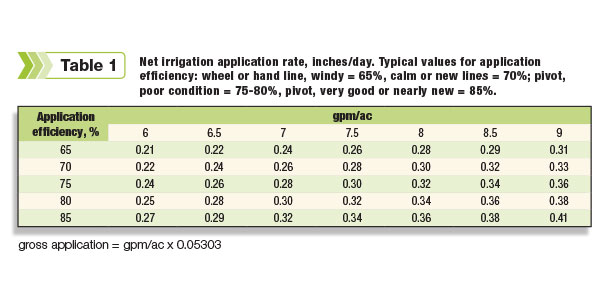The high three-day water use in southern Idaho is about 0.35 to 0.38 inches per day and occurs sometime around late July to the first week of August. For maximum corn production, the crop should not be stressed during certain crop stages.
The first stage is between V5 and V6 (when potential for ear size and kernel number is set), from V7 to V12 (when leaf size is being determined) and around V12 (where final ear size and kernel number are set). To assure minimal water stress throughout the season, consider the following practices.
Check soil moisture early
After planting, check soil moisture to a depth of at least 3 feet to determine the water available for plant use in the crop root zone (typically 2.5 to 3 feet if soil is that deep).
Use the procedure outlined in “Checking early season soil moisture” at the University of Idaho drought website to quantify soil moisture content at each depth checked.
Check pivot capacity early and compare to mid-season peak evapotranspiration
Not all water applied by a center pivot is available for plant use. Part is lost to evaporation and wind drift. To accommodate less-than-perfect water application uniformity, some additional water may be added to assure adequate water.
Net center pivot application rate – the depth of water applied that moves into the soil for later use by the plant – is usually given on the pivot operation chart supplied by the irrigation dealer.
However, in some cases, application rate on the charts does not include losses to evaporation, wind drift and non-uniformity. To account for losses, net application is usually determined by multiplying gross application by application efficiency (AE), usually about 0.85 for a pivot in good condition.

Also see Table 1 for values for hand or wheel lines.
To calculate the net water applied by a center pivot, the following equation may be used:
Gross application = gpm per acre x 0.05303
Net application = gross application x AE (in percentage) / 100
Example: What is the gross and net water application rate for a 125-acre pivot with 875 gpm water supply?
Application efficiency (AE) = 85 percent
gpm per acre = 875 / 125 = 7
Gross application = 7 x 0.05303 = 0.37 inches per day
Net application = 0.37 inches per day x (85 / 100) = 0.32 inches per day
In this case, the center pivot can apply no more than 0.32 inches per day that will be useful for crop production. If several days of crop ET (evapotranspiration) of more than 0.32 inches per day occurs, the water shortage must be supplied by stored soil water. When all available stored soil water has been used, crop stress will occur.
Fill profile early if needed
If calculated pivot application rate is less than the maximum ET for your area, you must assure availability of maximum stored soil water by filling the crop root zone to field capacity before the maximum crop water-use period.
If you enter that period with no soil water reserve, the pivot will fall farther behind each day that application rate is less than ET, and you will be unable to start catching up until this peak use period has passed.
The root zone soil depth may be filled by running several additional laps with the center pivot before mid-July. Soil moisture should be checked to root zone depth to assure no water is added beyond what is needed to re-fill the root zone.
This can be accomplished by using the procedure in the “Checking early season soil moisture” article on the UI drought website mentioned above.
Use some form of irrigation scheduling to match water applied to crop need
A number of irrigation scheduling procedures and devices exist. Most will perform well, but all require some degree of periodic soil moisture checking with depth by the grower to assure that no “drift” has occurred.
A discussion of some of these devices and scheduling approaches may be found in the Irrigation Scheduling portion of the UI website mentioned above.
In earlier field studies, I found that techniques ranging from the soil feel and appearance method to sophisticated soil sensor or data logger equipment could all work well if properly installed and used. Selection of the scheduling method depends upon grower preference and the amount of data desired for management purposes.
Additional considerations
In all three years of a recent sprinkler-irrigated study at Kimberly, Idaho, corn silage yield was essentially the same for plots adequately watered all season and for plots adequately watered until after pollination and then watered at 80 percent of ET for the rest of the season.
This practice can work on relatively deep soils but may not work as well on shallow or low water-holding soils. It has the additional advantage of reducing potential for soil compaction during harvest.
Maximum soil compaction will occur at soil moisture contents near field capacity, with compaction significantly reduced at drier soil moisture contents. FG
For more detail see the link to “Center Pivot Irrigation for Corn”, University of Idaho Extension Bulletin 881.

Howard Neibling
Extension Water Management Engineer
University of Idaho










